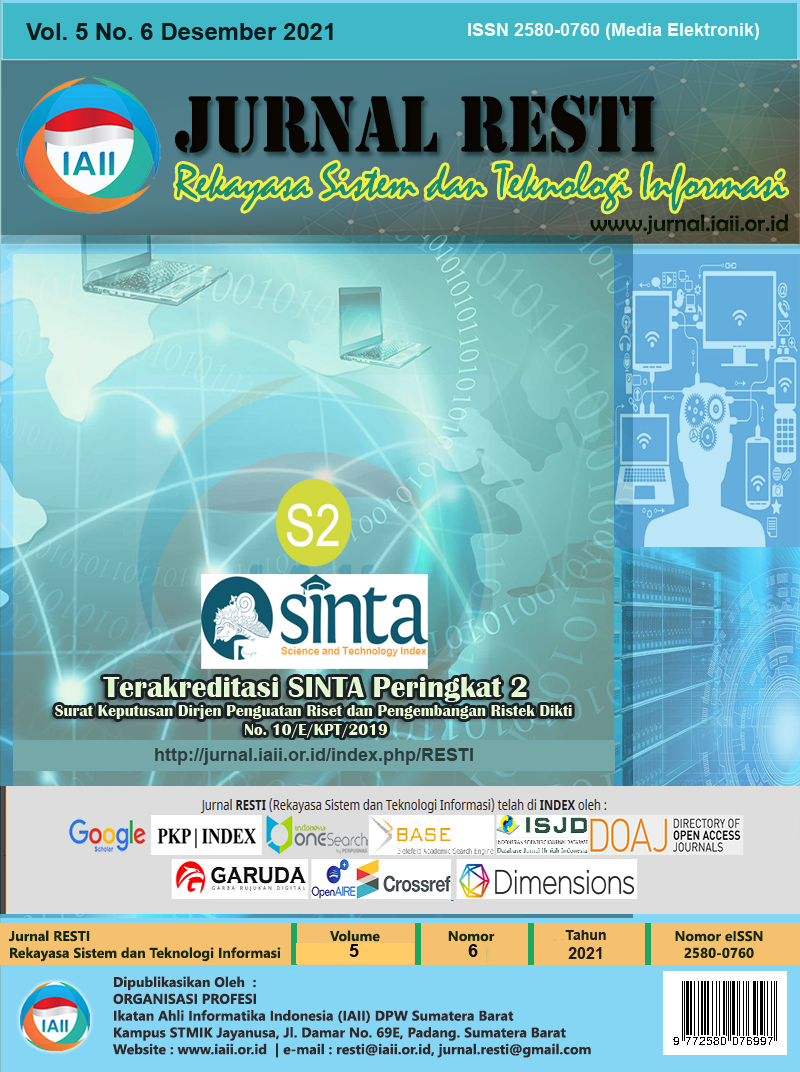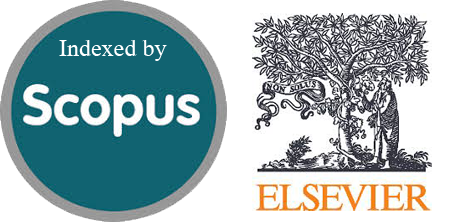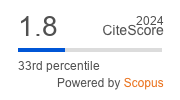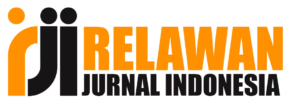Analisis Hybrid Decision Support System dalam Penentuan Status Kelulusan Mahasiswa
Hybrid Decision Support System Analysis in Determining Student Graduation Status
Abstract
Determination of graduation status is often faced by lecturers in every university. The facts show that many of the decisions still have a fairly high error rate in determining graduation status. This study aims to develop an analytical model in the process of determining student graduation using the Hybrid Decision Support System (DSS). The methods used in the analysis process are Analytical Hierarchy Process (AHP) and Technique for Others Preference by Similarity to Ideal Solution (TOPSIS). The performance of AHP can determine the value of the weight criteria and TOPSIS performs rankings to produce solutions in determining. The criteria indicators used to consist of Depth (C1), Material Breadth (C2), Answer Accuracy (C3), Fluency of Answers (C4), Scientific Attitude (C5), Logical Consistency of Content (C6), Authenticity (C7), Scientific Quality ( C8), Language (C9), and Writing (C10). The results of this study indicate that the Analytical Hierarchy Process (AHP) method provides a weighting value for each criterion with a fairly good accuracy rate of 85,86%. These results conclude that each criterion has a consistent level of relationship in determining student graduation. Based on the output of the TOPSIS analysis, the results presented can determine the student's graduation status correctly and accurately.
Downloads
References
A. Budianita and F. I. Pratama, “Penerapan Algoritma Klasifikasi Dengan Fitur Seleksi Weight By Information Gain Pada Pemodelan Prediksi Kelulusan Mahasiswa,” Infotekmesin, vol. 11, no. 2. Politeknik Negeri Cilacap, pp. 80–86, 2020, doi: 10.35970/infotekmesin.v11i2.255.
H. Hartatik, “Optimasi Model Prediksi Kelulusan Mahasiswa Menggunakan Algoritma Naive Bayes,” Indonesian Journal of Applied Informatics, vol. 5, no. 1. Universitas Sebelas Maret, p. 32, 2021, doi: 10.20961/ijai.v5i1.44379.
M. A. Al-Marom and S. Wibisono, “Sistem Penunjang Keputusan Rekomendasi Kelulusan dan Pemeringkatan Santri Menggunakan Metode AHP-TOPSIS,” Jurnal Ilmiah Media Sisfo, vol. 15, no. 1. LPPM STIKOM Dinamika Bangsa Jambi, p. 49, 2021, doi: 10.33998/mediasisfo.2021.15.1.998.
N. Heryana, F. Z. Ghassani, M. A. Usrahmawan, D. Juardi, and A. Solehudin, “Kajian Model Prediksi Ketepatan Kelulusan Mahasiswa: Sebuah Literatur Review,” Syntax, vol. 9, no. 1, pp. 54–62, 2020.
R. Damis, “Efektivitas Ujian Komprehensif Dalam Meningkatkan Kompotensi Mahasiswa Prodi Ilmu AqidaH,” Aqidah-ta J. Ilmu Aqidah, 2018, doi: 10.24252/aqidahta.v4i1.5173.
G. H. Medika and Z. B. Tomi, “Hubungan Lama Studi dengan Nilai Ujian Komprehensif Mahasiswa Program Studi Pendidikan Matematika IAIN Bukittinggi,” Sainstek J. Sains dan Teknol., 2020, doi: 10.31958/js.v12i1.2091.
A. Ardi, D. Aldo, and A. Ahmadi, “Sistem Pendukung Keputusan Menentukan Peserta Jamkesmas Dengan Metode Simple Additive Weighting,” J. RESTI (Rekayasa Sist. dan Teknol. Informasi), 2019, doi: 10.29207/resti.v3i2.802.
W. Setiawan, N. Pranoto, and K. Huda, “Sistem Pendukung Keputusan Evaluasi Kinerja Karyawan dengan Metode SMART (Simple Multi Attribute Rating Technique),” J. RESTI (Rekayasa Sist. dan Teknol. Informasi), 2020.
Sunardi, A. Fadlil, and R. Fitrian Pahlevi, “Pengambilan Keputusan Sistem Penjaminan Mutu Perguruan Tinggi menggunakan MOORA, SAW, WP, dan WSM,” J. RESTI (Rekayasa Sist. dan Teknol. Informasi), 2021, doi: 10.29207/resti.v5i2.2977.
F. Frieyadie and S. M. Ramadhan, “Penerapan Metode AHP Untuk Membantu Siswa Memilih Jurusan Yang Tepat Di SMK,” J. RESTI (Rekayasa Sist. dan Teknol. Informasi), 2018, doi: 10.29207/resti.v2i3.396.
Dodi Guswandi, “Sistem Pendukung Keputusan Pemberian Kredit Menggunakan Metode Analytical Hierarchy Process Pada Bank Perkreditan Rakyat (Bpr) Batang TarusaN,” Maj. Ilm. UPI YPTK, 2018, doi: 10.35134/jmi.v25i1.10.
Z. Li, Y. Xue, H. Wang, and L. Hao, “Decision support system for adaptive restoration control of transmission system,” J. Mod. Power Syst. Clean Energy, vol. 9, no. 4, pp. 870–885, 2021.
A. I. J. Nisa, R. Prawiro, and N. Trisna, “Analisis Hybrid DSS untuk Menentukan Lokasi Wisata Terbaik,” J. RESTI (Rekayasa Sist. dan Teknol. Informasi), 2021, doi: 10.29207/resti.v5i2.2915.
D. R. Sari, A. P. Windarto, D. Hartama, and S. Solikhun, “Sistem Pendukung Keputusan untuk Rekomendasi Kelulusan Sidang Skripsi Menggunakan Metode AHP-TOPSIS,” J. Teknol. dan Sist. Komput., 2018.
T. Nurhaeni, I. Handayani, R. A. Nurcahya, and A. Rifaldi, “Sistem Penilaian Sidang Komprehensif Tugas Akhir Skripsi dan Tesis Berbasis Yii Framework Menggunakan Business Intelligence Methodology,” Technomedia J., 2020, doi: 10.33050/tmj.v5i1.1330.
M. Yanto, “Penerapan Jaringan Syaraf Tiruan Dengan Algoritma Perceptron Pada Pola Penentuan Nilai Status Kelulusan Sidang SkripSI,” J. TEKNOIF, 2017, doi: 10.21063/jtif.2017.v5.2.79-87.
R. Kumar, “A combined AHP and TOPSIS approach for prioritizing the attributes for successful implementation of agile manufacturing,” Int. J. Product. Perform. Manag., vol. 69, no. 7, pp. 1395–1417, 2020, doi: 10.1108/IJPPM-05-2019-0221.
S. Pishyar, “A Combined AHP- and TOPSIS-Based Approach in the Assessment of Desertification Disaster Risk,” Environ. Model. Assess., vol. 25, no. 2, pp. 219–229, 2020, doi: 10.1007/s10666-019-09676-8.
I. Konstantinos, “A Decision Support System methodology for selecting wind farm installation locations using AHP and TOPSIS: Case study in Eastern Macedonia and Thrace region, Greece,” Energy Policy, vol. 132, pp. 232–246, 2019, doi: 10.1016/j.enpol.2019.05.020.
E. Mastrocinque, “An AHP-based multi-criteria model for sustainable supply chain development in the renewable energy sector,” Expert Syst. Appl., vol. 150, 2020, doi: 10.1016/j.eswa.2020.113321.
M. Yazdi, “Application of fuzzy fault tree analysis based on modified fuzzy AHP and fuzzy TOPSIS for fire and explosion in the process industry,” Int. J. Occup. Saf. Ergon., vol. 26, no. 2, pp. 319–335, 2020, doi: 10.1080/10803548.2018.1454636.
A. K. Singh, “A fuzzy-AHP and M - TOPSIS based approach for selection of composite materials used in structural applications,” Materials Today: Proceedings, vol. 26. pp. 3119–3123, 2019, doi: 10.1016/j.matpr.2020.02.644.
M. Abdel-Basset, “A Group Decision Making Framework Based on Neutrosophic TOPSIS Approach for Smart Medical Device Selection,” J. Med. Syst., vol. 43, no. 2, 2019, doi: 10.1007/s10916-019-1156-1.
G. Di Bona, “AHP-TOPSIS model to evaluate maintenance strategy using RAMS and production parameters,” Int. J. Oper. Quant. Manag., vol. 25, no. 3, pp. 175–201, 2019.
M. B. Anand and S. Vinodh, “Application of fuzzy AHP – TOPSIS for ranking additive manufacturing processes for microfabrication,” Rapid Prototyp. J., 2018, doi: 10.1108/RPJ-10-2016-0160.
I. Herman Firdaus, G. Abdillah, F. Renaldi, and U. Jenderal Achmad Yani Jl, “Sistem Pendukung Keputusan Penentuan Karyawan Terbaik Menggunakan Metode Ahp Dan TopsIS,” 2016.
L. Lukmandono, M. Basuki, M. J. Hidayat, and V. Setyawan, “Pemilihan Supplier Industri Manufaktur Dengan Pendekatan AHP dan TOPSIS,” OPSI, 2019, doi: 10.31315/opsi.v12i2.3146.
I. Petrovic, “A hybridized it2fs-dematel-ahp-topsis multi-criteria decision making approach: Case study of selection and evaluation of criteria for determination of air traffic control radar position,” Decis. Mak. Appl. Manag. Eng., vol. 3, no. 1, pp. 146–164, 2020, doi: 10.31181/dmame2003134p.
A. K. M. Masum, “A new hybrid AHP-topsis method for ranking human capital indicators by normalized decision matrix,” J. Comput. Sci., vol. 15, no. 12, pp. 1746–1751, 2019, doi: 10.3844/JCSSP.2019.1746.1751.
B. Febrilia, “Exploring student mathematical engagement using adapted watson’ analytical tool: A qualitative approach,” Cakrawala Pendidik., vol. 38, no. 1, pp. 188–202, 2019, doi: 10.21831/cp.v38i1.21478.
M. Ahsan, “What do they like and dislike from game-based entrepreneurship learning? A qualitative study,” Cakrawala Pendidik., vol. 40, no. 2, pp. 495–507, 2021, doi: 10.21831/cp.v40i2.38858.
Z. Ayağ and F. Samanlioglu, “Fuzzy AHP-GRA approach to evaluating energy sources: a case of Turkey,” Int. J. Energy Sect. Manag., 2020, doi: 10.1108/IJESM-09-2018-0012.
E. Rosiska, “Penerapan Metode Analitycal Hierarchy Process (AHP) dalam Menentukan Mitra Usaha Berprestasi,” J. RESTI (Rekayasa Sist. dan Teknol. Informasi), 2018, doi: 10.29207/resti.v2i2.419.
Z. Ayağ and F. Samanlioglu, “A hesitant fuzzy linguistic terms set-based AHP-TOPSIS approach to evaluate ERP software packages,” Int. J. Intell. Comput. Cybern., 2021, doi: 10.1108/IJICC-07-2020-0079.
E. R. Arumi and U. Yudatama, “Pemanfaatan Curiculum Vitae dan Sasaran Kinerja Pegawai untuk Penilaian Kinerja Dosen Menggunakan AHP,” J. RESTI (Rekayasa Sist. dan Teknol. Informasi), 2017, doi: 10.29207/resti.v1i3.57.
M. Sequeira, P. Hilletofth, and A. Adlemo, “AHP-based support tools for initial screening of manufacturing reshoring decisions,” J. Glob. Oper. Strateg. Sourc., 2021, doi: 10.1108/JGOSS-07-2020-0037.
C. Surya, “Penilaian Kinerja Dosen Menggunakan Metode TOPSIS (Studi Kasus : Amik Mitra Gama),” J. RESTI (Rekayasa Sist. dan Teknol. Informasi), vol. 2, no. 1, pp. 322–329, 2018, doi: 10.29207/resti.v2i1.119.
B. B. Gardas, R. D. Raut, N. Cheikhrouhou, and B. E. Narkhede, “A hybrid decision support system for analyzing challenges of the agricultural supply chain,” Sustain. Prod. Consum., vol. 18, pp. 19–32, 2019.
X. F. Zha, R. D. Sriram, M. G. Fernandez, and F. Mistree, “Knowledge-intensive collaborative decision support for design processes: A hybrid decision support model and agent,” Comput. Ind., vol. 59, no. 9, pp. 905–922, 2008.
N. Lestari, I. K. N. Wiyasa, and I. B. S. Manuaba, “Penerapan Model Pembelajaran Somatic, Auditory, Visualization, Intellectualy Berbantuan Multimedia Berpengaruh Terhadap Kompetensi Pengetahuan IPA,” J. Media dan Teknol. Pendidik., vol. 1, no. 1, pp. 11–21, 2021.
Copyright (c) 2021 Jurnal RESTI (Rekayasa Sistem dan Teknologi Informasi)

This work is licensed under a Creative Commons Attribution 4.0 International License.
Copyright in each article belongs to the author
- The author acknowledges that the RESTI Journal (System Engineering and Information Technology) is the first publisher to publish with a license Creative Commons Attribution 4.0 International License.
- Authors can enter writing separately, arrange the non-exclusive distribution of manuscripts that have been published in this journal into other versions (eg sent to the author's institutional repository, publication in a book, etc.), by acknowledging that the manuscript has been published for the first time in the RESTI (Rekayasa Sistem dan Teknologi Informasi) journal ;








